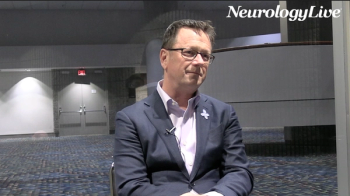
NeuroVoices: Shazam Hussain, MD, FRCP, FAHA, on Ultra-Early IV tPA to Treat Emergent LVO

The director of the Cerebrovascular Center at Cleveland Clinic provided context on why stroke systems should incorporate IV tPA as early as possible to treat emergent large vessel occlusion.
Time plays a critical role in the efficacy of intravenous (IV) thrombolysis for treatment of acute ischemic stroke (AIS). A recently performed retrospective analysis explored whether ultra-early administration of IV tissue plasminogen activator (tPA) within 60 minutes of symptom onset for AIS due to emergent large vessel occlusion (ELVO) is associated with a higher rate of recanalization. Although other studies have assessed outcomes after ultra-early treatment with IV tPA for stroke of any cause, there have been little data on the subgroup of ELVO strokes.
Among a cohort of 158 patients with AIS due to ELVO treated with IV tPA, those treated within the “golden hour” were found to have a higher rate of complete recanalization (28% vs 6.8%) and a better chance of early neurological improvement (76% vs 50.4%). Additionally, this patient population was associated with lower in-hospital mortality (adjusted OR, 0.13 [95% CI, 0.01-1.18]; P <.03), 90-day mortality (adjusted OR, 0.07 [95% CI, 0.01-0.74]; P = .005), and good clinical outcome (adjusted OR, 3.64 [95% CI, 1.42-9.34]; P <.01) at 90-day follow-up.
Senior author Shazam Hussain, MD, FCRP, FAHA, sat down with NeurologyLive for a new iteration of NeuroVoicesto discuss the motivation behind the study and the clinical significance of the findings. Hussain, director of the Cerebrovascular Center at
NeurologyLive: Why was this a pressing matter to investigate?
Shazam Hussain, MD: It was an interesting study for us to conduct. A lot of debate has been going on in the field about the role of intravenous tPA, particularly when you have large vessel occlusion. These are large blood clots that block off the main cerebral arteries. The debate stems from whether it’s useful to use the intravenous thrombolysis or better to just try to get a thrombectomy procedure done. The other interesting thing was that we have our mobile stroke unit here in Cleveland, which was one of the first in the country to have an ambulance unit with a CT scanner on board. We’re able to get the patients here much faster than ever before.
When we talk about the time from ambulance dispatch to when you can treat patients, we’re cutting down time to treatment by about 40 minutes, thus getting more patients treated in this “golden hour.” That’s the first hour after symptom onset. The other interesting thing we found was that for those patients with large vessel occlusions, which normally recanalize at rates between 10% to 20%, we were seeing much higher rates. These larger clots were dissolving which made us think, “Maybe it’s because we’re treating it so early.” That was the impetus for us to say, “Let’s look at our data. Let’s try to analyze patients treated in the first hour after symptom onset and let’s compare it then to a patient whose treated in another time window that’s still within the 4 and a half hours.” Getting into that golden hour early versus later on, is there a difference? That’s the impetus and rationale behind the study.
How can we streamline the practice suggestions of these findings into clinical practice?
Again, it helps us emphasize that this entire use of intravenous thrombolysis, particularly in that first hour after symptom onset, is so beneficial and can improve clinical outcomes. We talk about this mantra, time is brain. We want to treat patients as quickly as possible, but right now, we’re limited in the fact that it requires some time for someone who is having a stroke. Someone must recognize that stroke, call 9-1-1, and get that patient to the hospital. On a broad level, the first thing is getting back to the basics of stroke education and making sure patients and people in the public, know the signs and symptoms of a stroke. It’s estimated that only a third of people in the US know even one symptom of a stroke. That’s really disheartening.
We need people to understand the signs and symptoms because of how time-sensitive the condition is. There may be technologies that can help. Wearables are getting excited now as well, with the potential to detect stroke. Until that technology comes out, we need to have that education so that people call 9-1-1. We must then make sure the system is organized in a way where we can get those patients to the hospital as quickly as possible. That means our dispatchers have to be well-educated in stroke and our EMS teams are well-attuned with picking up those patients and getting them to a good hospital. They already do a good job with that, but it’s important to emphasize. Depending on the severity of the stroke, they may bypass specific hospitals.
Within the hospital system itself, we need to make sure we’re ready to go when these patients arrive. The other aspect, which we’ve demonstrated here in Cleveland, is having these mobile stroke units. We can get the CAT scan at the site of where the stroke is during, whether that’s in a person’s home or if they’re at their place of work. There’s no question anymore that the time to treatment is much faster with these mobile stroke units. Given that, our data compliments other big studies out of Berlin and Houston, the Be-Proud and BEST-MSU study, which again, emphasize how fast we can treat on mobile stroke and how it improves outcome. I think you’re going to see a push now towards implementing these mobile stroke units, which will help us treat many more patients in that golden hour.
Which aspects of stroke care still need improvement?
Unfortunately, we’re still in a situation where, although we’ve gotten better over time, we still need to make improvements in the system and work faster. Some of that is working with dispatchers about better identification of stroke. How do we work in the prehospital setting? We need to make sure our EMS colleagues are comfortable being able to identify stroke, stroke severity, and then getting the patient to the right place the first time is critical during that setting. That’s a matter of education, but there’s also interesting technology that’s coming out that can perhaps help the EMS colleagues that we have in the field. We need to make sure they have the tools they need to be able to successfully identify those patients and get them moving. Now, we have primary stroke centers, thrombectomy stroke centers, and comprehensive stroke centers.
Still, we want to make sure that those systems are well organized and that the people in those hospitals are paying attention to the fine details about how quickly we are moving these patients. Initiatives such as going directly to the CT scanner and having intravenous tPA available right in the emergency room are both big steps that work at shaving down that time. The general goal we’ve had when a person hits the door of the hospital, is to treat them within that hour. We’ve really been finding that we should be pushing that down to 45 minutes, and in some cases, even a half an hour. Using that to again, emphasize how important time is in the situation.
Transcript edited for clarity. For other editions of NeuroVoices,
REFERENCE
Lorenzo RD, Saqqur M, Buletko AB, et al. IV tPA given in the golden hour for emergent large vessel occlusion stroke improves recanalization rates and clinical outcomes. J Neurol Sci Psychiatry. Published online July 15, 2021. doi: 10.1016/j.jns.2021.117580
Newsletter
Keep your finger on the pulse of neurology—subscribe to NeurologyLive for expert interviews, new data, and breakthrough treatment updates.


































